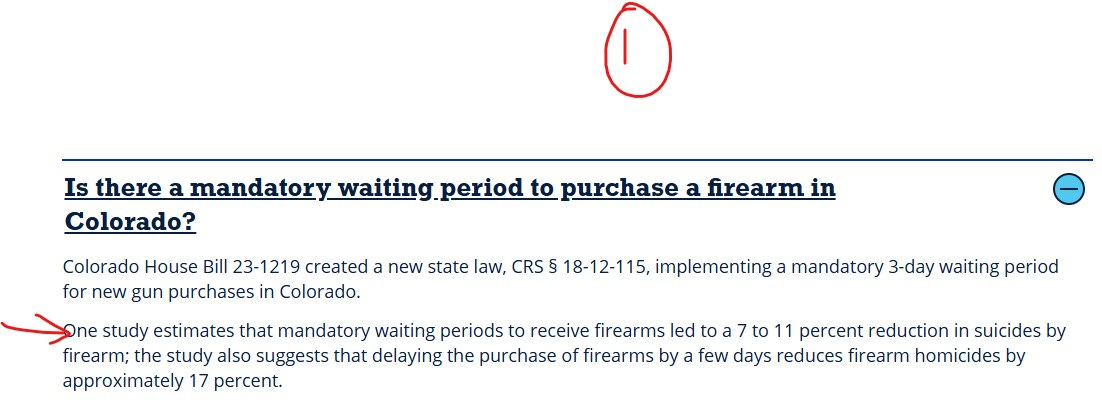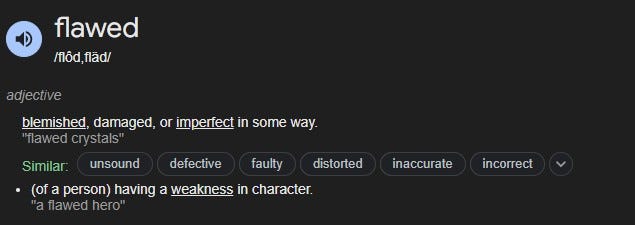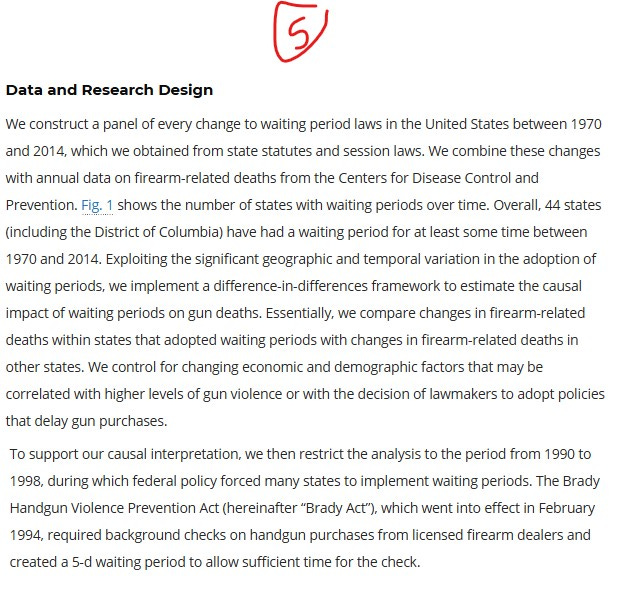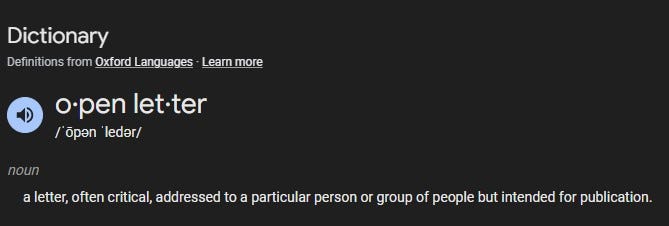Established by a 2021 law, CDPHE's Office of Gun Violence Prevention was intended to, according to the bill summary of the law that created it (linked below), "... coordinate and promote effective efforts to reduce gun violence".
Part of the Office's recent work has been to create a public-facing webpage, Let's Talk Guns Colorado, which is a sort of clearinghouse for information on a variety of gun safety topics and state gun policy.
Among the concerns of the legislators who voted against the Office's creation (and among the public who disagreed) was that the Office would be used as a dressed up way to deliver gun control talking points and further Democrat gun control efforts in this state.
Whether the Office has a pattern of doing that is up for reasonable debate, but in today's 3 part newsletter (linked below), I go into depth on a definite instance of the Office thoughtlessly forwarding gun control and Democrat talking points, along with an open email to the Office requesting that they either amend or remove said language.
https://leg.colorado.gov/bills/hb21-1299
A quick tour of Let's Talk Guns Colorado
CDPHE's Office of Gun Violence Prevention (OGVP) recently launched a website called Let's Talk Guns Colorado. I put a link to it first below.
It is a collection of tips, topics, and guides. For example, if you were, say, a doctor wanting to talk to your patients about safe gun storage or wanted info on filing an ERPO petition, you could find info here.
There are some good things on the site. I like their reminder to gun owners to treat every gun as if it's loaded, and never assume they've been around guns so long that they can be cavalier. Can't say things like that often enough.
There are also some things that I disagree with philosophically. Returning to my example above, I do not like the idea of medical providers asking about how many guns I have or where/how I store them. It's their right, it's not illegal to ask, but I don't like the question. If I ever get it, I'll politely decline to answer and tell the provider not to ask again.
Despite philosophical differences, I didn't see anything in here that I thought overtly wrong or concerning. I didn't, that is, until I got to the site's FAQ's page, specifically the question about 3 day waiting periods for purchasing firearms. See screenshot 1 attached.
Note what I highlighted at the bottom of the screenshot. Now turn to the language in the screenshots labeled "Bill" and "Giff". See the similarity?
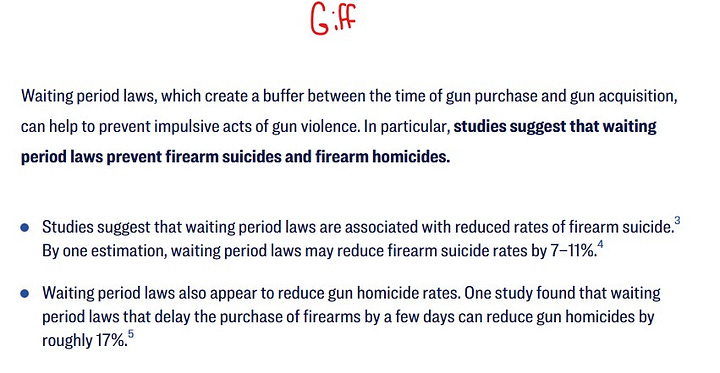
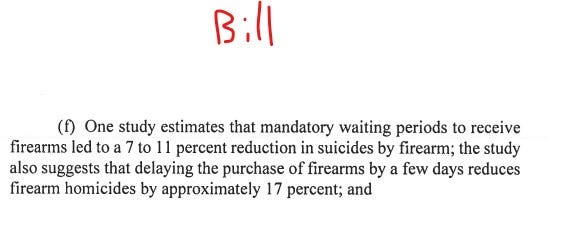
Those screenshots come from the bill text for HB23 1219 and Giffords (a gun control group) website. I linked to the bill and Giffords waiting period webpages second and third below for reference.
All of these statements trace back to the same flawed study; they make their claims about the efficacy of background checks based on a 2017 paper by Luca et. al. I will take up the flaws in the following post (and I will repeat my concerns to the people at the OGVP when I send my open email in part 3), but I can take up the issue in a broad sense now.
Flawed studies have this nasty habit of being "sticky": they manage to work themselves into one person's argument and, when they're useful to some group, they manage to leave some trace of their tackiness on other sites by having their arguments thoughtlessly forwarded.
This is bad enough on its own. This is bad enough (though perhaps not wholly unexpected) when advocates like the Colorado Democrats and gun control groups like Giffords do it.
It is worse when a supposedly non-partisan government agency thoughtlessly forwards gun control talking points. That is what has happened here. OGVP, via its "Let's Talk Guns Colorado" site has chosen to, without caveat and without any other perspectives, forward shoddy research about gun waiting periods.
This goes counter to decency, it goes counter to what we'd expect from government agencies that we all support via our taxes, and it goes counter to the OGVP's own wording on their website, where phrases like "Let’s cut through the misinformation" and "Let's keep gun safety honest" are in giant bold font.
https://letstalkgunscolorado.com/
https://leg.colorado.gov/sites/default/files/2023a_1219_signed.pdf
https://giffords.org/lawcenter/gun-laws/policy-areas/gun-sales/waiting-periods/#footnote_4_5633
Why did I refer to the study that the Colorado Dems, Giffords (a gun control group), and now the Office of Gun Violence Prevention (OGVP), used as "flawed"?
I'll flesh it out. Note that what I write below will be a partial summary due to space concerns, but it will still be a challenge. Take your time and be ready to read more than once. If you have questions, please feel free to contact me.
In essence, my (and David Kopel who wrote at length about the study's problems) issues boil down to the fact that the study has some logical inconsistencies, problems with its method, and the authors draw conclusions which go far outside the methods used to produce them.
These problems combine to make any statement that either the authors or the groups using the study suspect in the least.
Let's dive in. For reference, I include a link to the study first below. I will be referring it as the PNAS (Proceedings of the National Academy of Sciences) study from here forward.
Mr. Kopel wrote written testimony in opposition to the waiting period bill when it was being heard by committee. This testimony was reprinted by Complete Colorado at the time. I link to that second below.
In his testimony Mr. Kopel, among other things, outlines his concerns with the PNAS study used by the Democrat sponsors of the bill as part of its rationale in the legislative declaration.
For the sake of brevity (the written testimony covers a broad range of topics outside that of the study referenced), I excerpted his concerns regarding the study as pictures and attached them as screenshots 1 - 4. Note: there is a gap in Mr. Kopel's testimony between screenshots 3 and 4. For the full text, I refer you to the link.
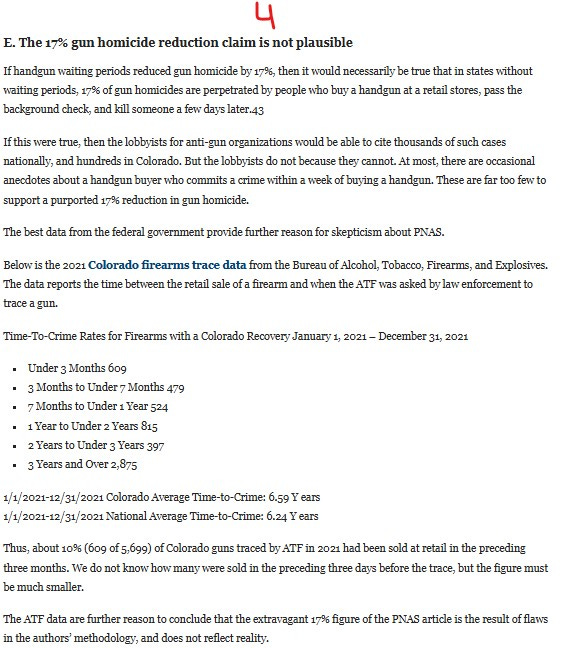
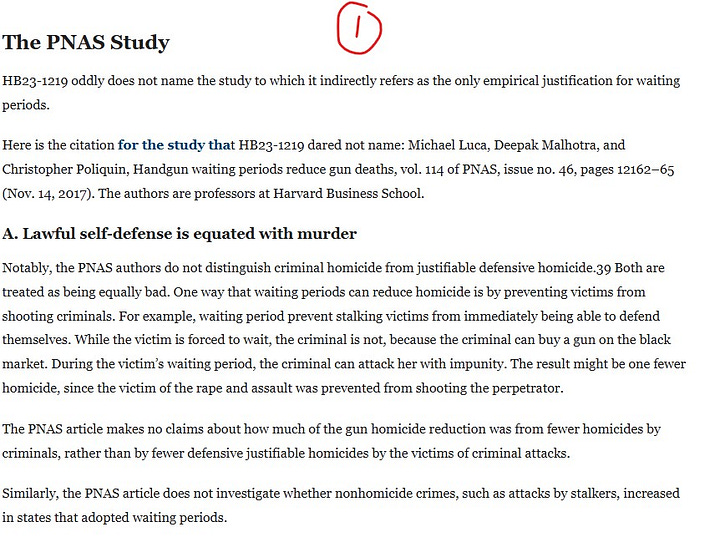
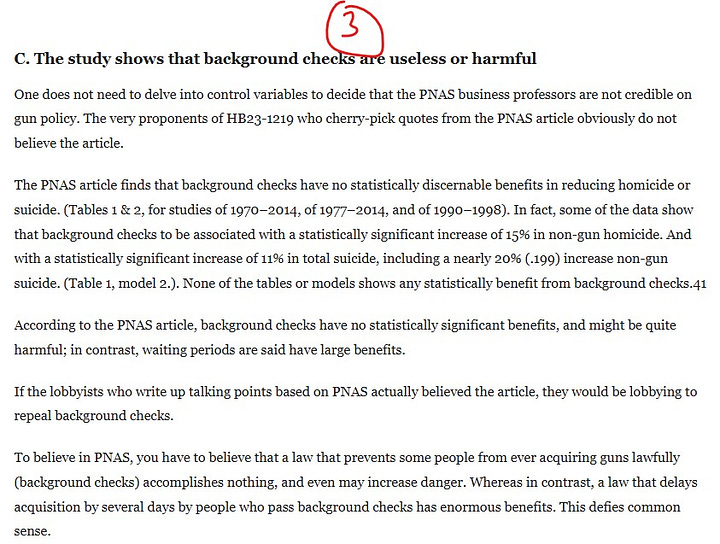
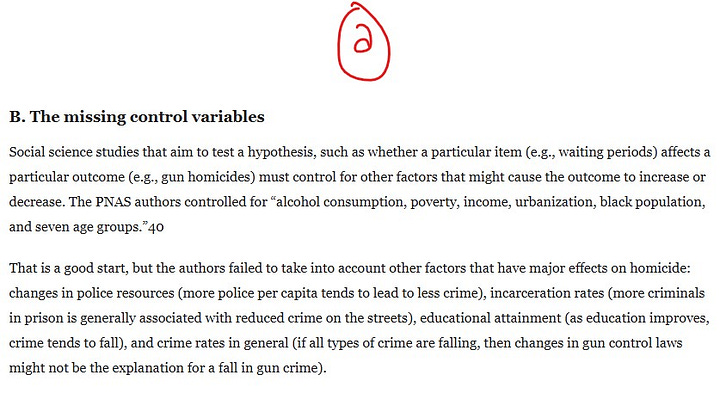
Mr. Kopel touches on concerns with the PNAS study's method. These are concerns I share, but I have others that go beyond what he touched on.
This part could get hugely technical and turn into a book, so for the sake of brevity, I will share my concerns and try, via a couple examples, to give you a sense of those issues in a non-technical way.
First let's discuss what the authors did. Screenshot 5 attached comes from the PNAS study. Removing the more technical language (and the language justifying the researchers' leap to a causal connection from correlation data), you are left with the following for their method.
The researchers went to the CDC and got data on the numbers of deaths for homicides, suicides both non- and gun-related. They then looked at how those rates compared across states with and without gun purchase waiting periods.
This approach, as you are likely already thinking, has a number of flaws, the fact that states are made of people (who are different), that they vary across time, that there may be factors changing the death rates for guns wholly apart from gun policy that researchers didn't account for among them.
This is, was, and will always be the problem with trying to establish causality from correlation. Nonetheless, the researchers repeatedly refer to their work as establishing a causal connection. This is the first and biggest of their oversteps.
In order to bolster their claim, the PNAS authors spend a great deal of time on statistical sophistry, one of their biggest being the claim that the Brady Act of 1994 provided what statisticians call a "natural experiment". Again, you run into the same problem with this as above. The controls in this natural experiment are not only missing, they're not knowable due to the complexity of our world.
At the end of the day, no matter the words, you must remember that the PNAS study draws its conclusions from a simplified version of reality, a model.
In order to try and winnow down all the various complexities in reality that could be confounding your study results, authors try to "control" for various things that might be changing their results. For example, it seems natural that poverty and violence of all kinds might go hand in hand (they do), so a careful look at data would figure how to remove any effects of poverty in violence.
The PNAS study authors, by choosing whole-population data, however, bought themselves the horrible problem of a huge number of factors that could change their data.
They attempt to fix this by including controls at the state level for (quoting the study) "..alcohol consumption, poverty, income, urbanization, black population, and seven age groups"
Further, in another common social science technique, the study authors put in controls for what are known as "fixed effects", that is variables that they assume do not change across time or across states but yet might have an effect on gun violence (again, quoting): "...policing tactics, drug use, and environmental factors such as lead exposure might not have changed uniformly across states over time and may also affect violence."
A couple of questions follow: how are you sure you got all the different factors controlled for, and how sure are you that the things you assumed are fixed are ... actually fixed? That they don't change?
Take a look at screenshots 6 - 8 attached. They are from a website called Statista (linked third below) and they give statistics on the national poverty rate from 1990 to 2023, Colorado's rate from 2000 to 2023 and Alabama's rate from 2000 to 2023 respectively.

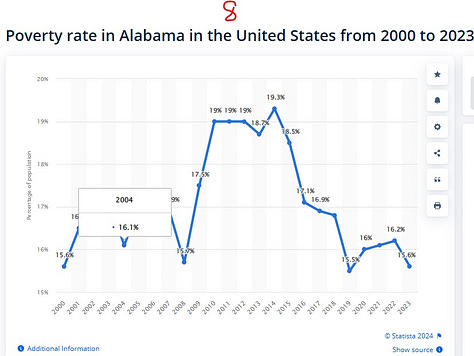
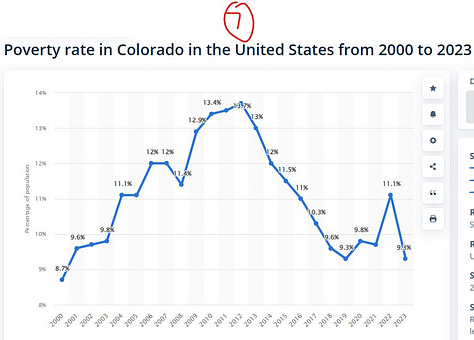
Note how much something like poverty changes across time for our whole country. Note how much it changes across time for a state. Note how much it changes across states for the same time period.
I am not sure how the researchers controlled for poverty. I'm also not sure what "fixed" things they controlled for.
I used poverty here as an example because it was an easy statistic to get as a time series. It is illustrative of just how complex the world is and just how wanting attempts to control that complexity can be. I.e. even "fixed" things may not be so fixed.
Turn lastly to screenshots 9-11. They are a screenshot of Table S7, Table S8, and Table 1 from the PNAS paper respectively.
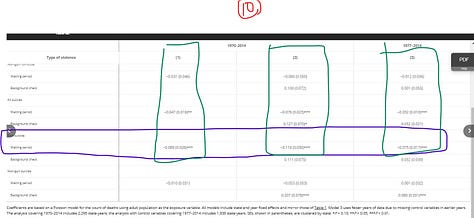
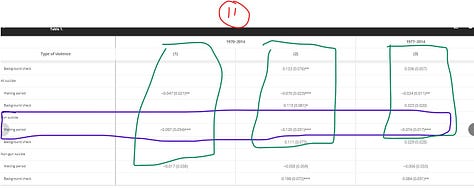

The highlighting in each is the same. Across the top you have different models the researchers used (boxed in green as 1, 2, and 3), and I chose the row that picked out the reductions in gun suicides across models and time in blue.
Note the variability across any given row, and the variability for any given number (cell) between any two screenshots.
The point here is not that this or that number is the right one. The point is not that this or that treatment is the one that gives the right result (we wouldn't know).
The point is is the wild variation in numbers. The point is how much one treatment, one way of parsing the data, varies compared with another. If adding or removing a control variable, if changing the way that you calculate causes changes like you see here, how confident can you be that you've got the right way to do it, or that your numbers are the "true" ones.
After all, I could come in add or remove things to say waiting periods are more effective, not at all effective, or perhaps counterproductive in reducing suicide.
Thus always the problem. You do not know the actual contributing factors, you cannot control for them all, and you do not really have a good sense as to whether you have the ones that have a big effect.
ttps://www.pnas.org/doi/10.1073/pnas.1619896114
https://pagetwo.completecolorado.com/2023/03/01/kopel-colorado-bill-forcing-delay-of-firearms-acquisition-on-shaky-constitutional-ground/
https://www.statista.com/
We have arrived at the final post in the three-part series.
This post has my open letter to the Office of Gun Violence Prevention (OGVP) at CDPHE regaring their thoughtlessly forwarding flawed gun control, Colorado Democrat talking points.
My open email is in the screenshots attached. I urge you to follow suit. If you are a gun owner and you see things that are not true, speak up.
If it's in a newspaper, write the paper/reporter and politely but firmly explain what they have wrong. Ask for a correction or a change.
If it's a politician, write him or her and politely but firmly explain what they have wrong. Ask for a correction or a change. .
If it's a government agency, write them and politely but firmly explain what they have wrong. Ask for a correction or a change.
Speaking up is important because only by speaking up do you push back against a relentless narrative about guns and gun owners.
Just so you have it, if you notice something wrong in Let's Talk About Guns Colorado or on the OGVP site, the email contact for them is ogvp@state.co.us





